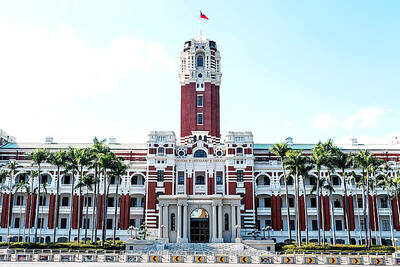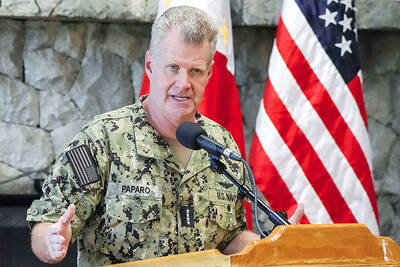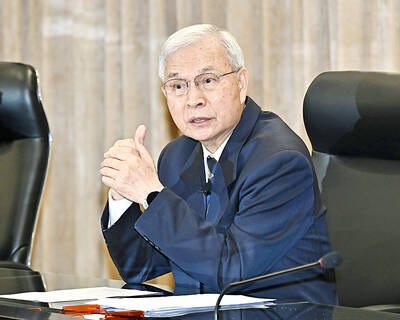A brutal week on Wall Street ended with the approval of a massive US government lifeline for the troubled financial sector, but investors are still searching for a reason to cheer.
The US$700 billion plan is expected to help start a recovery from a US housing meltdown, but some argue it’s not clear when a global credit crunch that is choking off economic activity will start to ease.
The huge bailout “should alleviate some of the stress that has been building up in the US financial markets over the past several weeks,” said Brian Bethune, economist at Global Insight. “However, it would be naive to assume that these measures alone will be a panacea for the economy. The economy is in the midst of a recession.”
The Dow Jones Industrial Average of 30 blue-chips plummeted 7.34 percent for the week to 10,325.38, including last Monday’s record loss of 777 points.
The broad-market Standard & Poor’s 500 index saw an even steeper loss of 9.39 percent for the week to 1,099.23 while the technology-heavy NASDAQ composite plunged 10.8 percent to 1,947.39.
The stomach-churning week on Wall Street came amid a further freeze-up of global credit markets, virtually shutting down interbank lending and threatening to further roil a weak economy.
“There is nearly an unbearable amount of fear and panic in the financial markets today. Indeed, for investors it seems in times like these there are few places to hide,” Scott Anderson at Wells Fargo Economics said.
Standard & Poor’s analysts said the freeze-up was a situation where “fear overtakes fundamentals.”
Some investors had pinned hopes on congressional approval of the financial rescue plan to help banks and other firms shed their distressed assets from the US real estate collapse. But even after the bill was passed, tensions remained high.
“The economy was toast without this package,” said John Ogg, an analyst at financial Web site 24/7 Wall Street.
“But the economy is still likely going to suffer and enter into a recession ... This bill may not be enough and it may already be too late,” Ogg said.
Peter Cohan, of the consulting firm Peter Cohan & Associates, said the plan leaves many questions unanswered.
“I think that unless the Treasury can solve the thorny problem of setting a price for the mortgage-backed securities (MBS) and collateralized debt obligations (CDOs), then it will fail to solve the real economic problem — which is a lack of trust in the financial system,” he said.
The market was reminded of a weak economy with data showing a loss of 159,000 jobs last month. Earlier in the week, data showed a sharp 4.0 percent slide in factory orders.
Further underscoring the economic malaise, US auto sales took a beating last month as the worsening economy turned dealer showrooms into ghost towns and major automakers reported sales drops of up to 37 percent.
“The question is no longer whether the economy is in a recession, but will it be a ‘lower-case’ recession or an ‘upper-case’ recession,” Ethan Harris at Barclays Capital said. “We now expect the latter.”
Amid the gloom, there was little room for optimism, but some analysts said the selling may have reached the point of climax.
“There are some truly compelling indications that the market is looking for a bottom that could put the lows in for some time,” said John Wilson, equity strategist at Morgan Keegan in a note to clients.
“It could take a few months to develop or it could be happening now. We won’t know until we have some hindsight, but I believe long-term investors (truly long-term investors) should be adding to stocks,” he said.
Bond prices gained over the week as investors flocked to safety. The yield on the 10-year Treasury bond eased to 3.644 percent from 3.827 percent a week earlier, and that on the 30-year bond fell to 4.123 percent from 4.357 percent. Bond yields and prices move in opposite directions.

The CIA has a message for Chinese government officials worried about their place in Chinese President Xi Jinping’s (習近平) government: Come work with us. The agency released two Mandarin-language videos on social media on Thursday inviting disgruntled officials to contact the CIA. The recruitment videos posted on YouTube and X racked up more than 5 million views combined in their first day. The outreach comes as CIA Director John Ratcliffe has vowed to boost the agency’s use of intelligence from human sources and its focus on China, which has recently targeted US officials with its own espionage operations. The videos are “aimed at

STEADFAST FRIEND: The bills encourage increased Taiwan-US engagement and address China’s distortion of UN Resolution 2758 to isolate Taiwan internationally The Presidential Office yesterday thanked the US House of Representatives for unanimously passing two Taiwan-related bills highlighting its solid support for Taiwan’s democracy and global participation, and for deepening bilateral relations. One of the bills, the Taiwan Assurance Implementation Act, requires the US Department of State to periodically review its guidelines for engagement with Taiwan, and report to the US Congress on the guidelines and plans to lift self-imposed limitations on US-Taiwan engagement. The other bill is the Taiwan International Solidarity Act, which clarifies that UN Resolution 2758 does not address the issue of the representation of Taiwan or its people in

US Indo-Pacific Commander Admiral Samuel Paparo on Friday expressed concern over the rate at which China is diversifying its military exercises, the Financial Times (FT) reported on Saturday. “The rates of change on the depth and breadth of their exercises is the one non-linear effect that I’ve seen in the last year that wakes me up at night or keeps me up at night,” Paparo was quoted by FT as saying while attending the annual Sedona Forum at the McCain Institute in Arizona. Paparo also expressed concern over the speed with which China was expanding its military. While the US

SHIFT: Taiwan’s better-than-expected first-quarter GDP and signs of weakness in the US have driven global capital back to emerging markets, the central bank head said The central bank yesterday blamed market speculation for the steep rise in the local currency, and urged exporters and financial institutions to stay calm and stop panic sell-offs to avoid hurting their own profitability. The nation’s top monetary policymaker said that it would step in, if necessary, to maintain order and stability in the foreign exchange market. The remarks came as the NT dollar yesterday closed up NT$0.919 to NT$30.145 against the US dollar in Taipei trading, after rising as high as NT$29.59 in intraday trading. The local currency has surged 5.85 percent against the greenback over the past two sessions, central